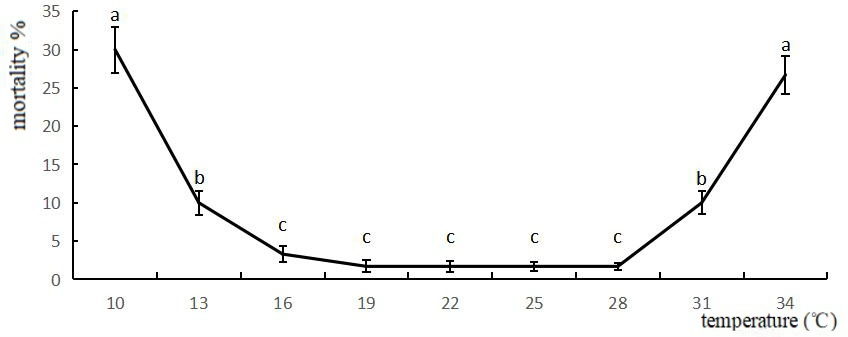Analysis of the Main Factors Inducing Mortality in Artificial Ponds for Australian Freshwater Lobsters
Abstract
With rising demand for Cherax quadricarinatus due to advancing aquaculture technology and consumer preference, this imported species faces strict environmental needs and technical challenges. Poor water quality and temperature extremes during breeding often cause mortality and yield losses, impacting farmers economically. This study analyzes primary mortality causes in artificial ponds through breeding experiments, collecting data on temperature, dissolved oxygen, ammonia nitrogen, nitrate nitrogen, and Vibrio infection. Key factors identified include temperatures ≤10°C or ≥31°C, dissolved oxygen ≤1.0 mg/L, and ammonia nitrogen or nitrate nitrogen ≥0.5 mg/L. These findings enhance understanding of artificial pond conditions affecting C. quadricarinatus, offering a reference for improving aquaculture practices.
References
[2] Ye, X. (1996). An introduction to the Australian red-claw lobster. Henan Aquaculture, (1), 19. (No DOI available)
[3] Gu, Z., Xu, G., Mi, G., & et al. (1997). Domestic and international cultivation and development prospects of the red-claw lobster. Aquaculture, (2), 22–24. (No DOI available)
[4] Zhang, K., Huang, H., & Yan, S. (1996). A promising new species in aquaculture – The Australian red-claw freshwater lobster. Xiamen Science and Technology, (3), 13, 15. (No DOI available)
[5] Meng, S. (2003). Cultivation techniques for the Australian freshwater lobster. Feed Expo, (4), 42. (No DOI available)
[6] Zeng, F. (2020). High profit margins in Australian lobster farming but concerns over seed quality. Ocean and Fisheries, (12), 19–21. (No DOI available)
[7] Author(s) not specified. (2018). Reconstructing the "Land of Fish and Rice" in the Jianghan Plain – A record of rural industrial revitalization led by the “Double Water, Double Green” model in Jingzhou City, Hubei. Rural Science Experiment, (10), 1–2. (No DOI available)
[8] Li, W. (2018). A freshwater aquaculture subject worth noting: The lobster. Aquaculture Information, 41(1), 12–19. (No DOI available)
[9] Li, W. (2017). A discussion on world freshwater aquaculture [Doctoral dissertation, Shandong Normal University]. (No DOI available)
[10] Tao, S., Wang, Z., & Wang, G. (2010). Analysis and research on methods for determining dissolved oxygen. Zhi Huai, (12), 46–47. (No DOI available)
[11] Irja, H., Lauri, J., Martin, V., & et al. (2009). Micro-Winkler titration method for dissolved oxygen concentration measurement. Analytica Chimica Acta, 648(2), 167–173. https://doi.org/10.1016/j.aca.2009.06.061
[12] Sahoo, P., Ananthanarayanan, R., Malathi, N., & et al. (2010). Pulsating potentiometric titration technique for assaying trace levels of dissolved oxygen in water. Analytica Chimica Acta, 669(1–2), 17–24. https://doi.org/10.1016/j.aca.2010.04.030
[13] Li, H. (1992). Feasibility report on the colorimetric determination of dissolved oxygen in water. Marine Science, (1), 69–70. (No DOI available)
[14] Wang, Z., Li, J., Liu, L., & et al. (2014). Development and application of a new eco-friendly rapid detection kit for ammonia nitrogen in water. Chinese Journal of Health Inspection, 24(15), 2146–2148. (No DOI available)
[15] Liao, J. (2010). A review of methods for detecting nitrate and nitrite in water. Guangdong Chemical Industry, 37(5), 304–306. (No DOI available)
[16] Huo, S., Jiao, H., Li, Q., & et al. (2022). Isolation, identification, and antibiotic sensitivity of Vibrio parahaemolyticus from red-claw lobsters. Journal of Aquatic Ecology, 43(01), 124–129. https://doi.org/10.15928/j.1674-3075.201911200289
[17] Yu, J., & et al. (2020). Effects of stocking density and artificial macrophyte shelter on survival, growth and molting of juvenile red swamp crayfish (Procambarus clarkii) under experimental conditions. Aquaculture, 521, Article 735001. https://doi.org/10.1016/j.aquaculture.2020.735001
[18] Rigg, D., & et al. (2020). A review of juvenile redclaw crayfish Cherax quadricarinatus (von Martens, 1898) aquaculture: Global production practices and innovation. Freshwater Crayfish, 25, 13–30. (No DOI available; journal may not assign DOIs)
[19] Qianqian, & et al. (2021). Etiological characteristics of “tail blister disease” of Australian redclaw crayfish (Cherax quadricarinatus). Journal of Invertebrate Pathology, 184, Article 107643. https://doi.org/10.1016/j.jip.2021.107643
[20] Yu, Y.-B., & et al. (2022). Shrimp bacterial and parasitic disease listed in the OIE: A review. Microbial Pathogenesis, 166, Article 105545. https://doi.org/10.1016/j.micpath.2022.105545


This work is licensed under a Creative Commons Attribution 4.0 International License.
Copyright for this article is retained by the author(s), with first publication rights granted to the journal.
This is an open-access article distributed under the terms and conditions of the Creative Commons Attribution license (http://creativecommons.org/licenses/by/4.0/).
























